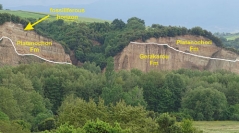

 Comptes Rendus Palevol
14 (5) - Pages 353-362
Comptes Rendus Palevol
14 (5) - Pages 353-362Two new vertebrate fossiliferous localities from the Pleistocene of the Mygdonia Basin (Macedonia, Greece), Tsiotra Vryssi (TSR) and Platanochori-1 (PLN), are presented in this article. TSR belongs to the Gerakarou Formation and its preliminary faunal list includes the corvid Corvus pliocaenus, the hyaenid Pachycrocuta brevirostris, the canid Canis etruscus, the rhinoceros Stephanorhinus sp., two species of Equus, the bovid Bison sp., the cervid Metacervocerus rhenanus and the giraffid Palaeotragus sp. PLN belongs to the Platanochori Formation (overlying Gerakarou Formation) and its fauna includes the following taxa: Stephanorhinus hundsheimensis, Equus apolloniensis, Bison sp. and Pontoceros ambiguus. The preliminary comparison of these faunal assemblages with the already known localities from the Mygdonia Basin and the wider region, combined with the geological data, suggest a Late Villafranchian age for TSR, chronologically intermediate between the localities Gerakarou-1 and Apollonia-1, while the fauna from PLN is indicative of a Latest Villafranchian age, similar to that of Apollonia-1. These new localities will enhance our understanding of the crucial time period of the earliest dispersal of hominins into Europe.
Villafranchian, Tsiotra Vryssi, Platanochori-1, Fauna, Mammals, Age